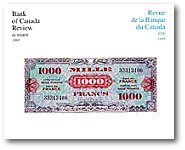Summer 1995

|
Aspects of economic restructuring in Canada, by Ron Parker
Uncertainty and the transmission of monetary policy in Canada (HERMES-Glendon Lecture) [speech]
|
Cover: France: 1,000 francs, 1944
This 1,000 franc note was issued on 6 June 1944 for use by the Allied troops that participated in the invasion of France. Well before the invasion, the Allies had decided to use a common currency that would be denominated in units of the country in which it was to be used: here, the note is in French francs for use in France. The design on all denominations was the same, however, to emphasize Allied solidarity.
The United States Bureau of Engraving and Printing was the first to be asked to produce a series consisting of 2, 5, 10, 50, 100, 500, 1,000 and 5,000 franc notes, but it was unable to do so, owing to other more pressing wartime demands. The contract was given to the Forbes Lithographic Corporation of Chelsea, Massachusetts.
Issued on orders from Dwight D. Eisenhower and bearing a French flag on the back, the new notes caused a controversy, because General Charles de Gaulle protested their use and declared the entire issue counterfeit. The French provisional government subsequently arranged for a second, similar series ranging from 50 to 5,000 francs to be printed by Forbes, but with the word “FRANCE” in place of the French flag. The Allied notes of the first series circulated from 6 June 1944 through 15 June 1945. The second issue circulated from 15 June 1945 through September 1946 and included the 2, 5, and 10 franc notes of the first series. The 5,000 franc notes were never issued, although specimen notes do exist.
The 1,000 franc note is part of the National Currency Collection, Bank of Canada.
Photography by James Zagon.




